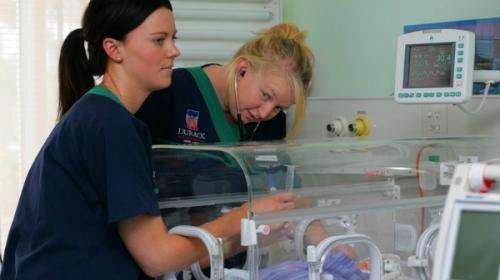Ms Myers says putting a number value on nurse staffing levels is part of an on-going ECU project, with researchers seeking to gather hard evidence to protect the profession and the public. Credit: Tradimus
Patients exposed to understaffed nursing shifts have a significantly greater chance of suffering conditions such as surgical wound infections, pressure injuries, urinary tract infections and pneumonia.
This finding from an Edith Cowan University study that analysed two years of local hospital data involving 36,529 patients.
In total, 17,025 (46.6 per cent) were exposed to at least one understaffed shift.
This led to a three to eight per cent higher chance of suffering an adverse nurse-sensitive outcome (NSO).
Co-author Helen Myers says the study took a novel patient-centred approach to evaluating the staffing/patient care relationship.
"The difficulty with this sort of research is that it is usually done at the hospital level, looking at outcomes by wards or from an overall perspective," she says.
"But hospitals are incredibly complex environments, and patients go to many wards, so we assigned structural variables taking movements into account to work out if patients had been exposed to understaffed shifts during any part of their stay.
"We wanted to add more precision to evaluating the problem."
Non-urgent issues rise with less nurses
While understaffed shifts weren't a factor in major health events such as pulmonary failure, cardiac arrest or shock the researchers found a significant increase in non-urgent conditions.
"If a major event occurs, people are going to notice," Ms Myers says.
"But the smaller issues indicate an effect on the surveillance role nurses have.
"They are in the best position to detect changes in a patient at an early stage, effectively stopping minor health issues before they escalate into major problems."
Stopping adverse NSOs saves both patient suffering and money for the healthcare system, with each incidence adding an estimated $8000 and one week to the cost of care.
Ms Myers says putting a number value on nurse staffing levels is part of an on-going ECU project, with researchers seeking to gather hard evidence to protect the profession and the public.
She points to cutbacks in the UK health system.
"To date, we haven't seen a major problem with understaffing in Western Australian hospitals, but there are always economic pressures on the healthcare sector, with nurses having been a target in restructuring overseas," she says.
"We need to ensure an adequate number of nurses for patient well-being and make sure that our nurses are supported."
She says short-staffing can be structural, such as a shortage in graduates, geographical or related to workplace conditions.
More information: "The impact of understaffed shifts on nurse-sensitive outcomes." Journal of Advanced Nursing 00(0), 000–000. DOI: 10.1111/jan.12616
Journal information: Journal of Advanced Nursing
Provided by Science Network WA



















